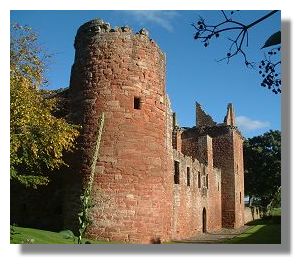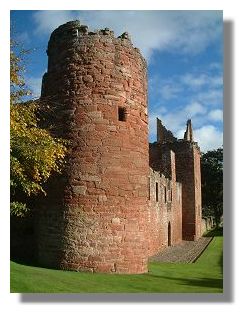
Places to Visit in Scotland
- Edzell Castle, Angus

The Lichtsome Lindsays
The earliest castle known at Edzell was built in the 1100s of earthwork-and-timber on a hillock about 300 metres south-west of the present building. Nothing of this structure remains, apart from the steep sides of the "motte" (the Norman word for mound) encircled by a wide ditch. This early castle was created by the Abbotts who in turn were succeeded as lairds of Edzell by the Stirlings of Glenesk. In 1358 the daughter and heiress of Sir John Stirling married Sir Alexander Lindsay and the estate remained in the hands of the Crawford Lindsays for over 350 years.
The "lichtsome" (carefree) Lindsays lived in turbulent times in Scotland's history. Sir David de Lindsay took part in a famous tournament in London in 1390 in front of King Richard II of England. He won so easily that there was a suggestion that he was tied to the saddle - until he jumped off his horse. It is thought that Sir David may have been the organiser of the "Battle of the Clans" at Perth in 1396, which was staged in front of King Robert III. Sir David was later created Earl of Crawford and in 1403 he became Lord High Admiral of Scotland, one of the most powerful men in Scotland.
In the middle of the 1400s, his grandson made Edzell a separate inheritance for his younger son and it this junior branch of the family who expanded the castle and created the unique garden which adjoins it.
The Phases of Construction

Although incorporating elements from earlier structures, the building seen today began with an L-shaped tower house (on the right of the illustration here) in the early 16th century, which provided accommodation for the Lindsay family. It rose to five storeys and there would be a walled courtyard which, over the years, provided the shape for further buildings. The west range (in the centre of the illustration) was built around 1553 and would have been complete by the time Mary Queen of Scots paid a visit in August 1562. During her stay, she held a Privy Council meeting attended by the most powerful nobles in the kingdom. The lord and his family had their living quarters in the west range, having out-grown those in the tower house.By the end of the 16th century, apartments were begun on the northern side of the site, including a hall on the first floor for large-scale entertaining and a round stair-tower on the corner.
When the final two sides of the property were built, they housed the servants, a bakery and even a small brewery.
The Walled Garden
Although the 16th century had its share of violence and conflict, not least during the Reformation and the abdication of Mary Queen of Scots, the need for a purely defensive castle was declining and the nobility were moving steadily towards a more comfortable style of living. The Union of the Crowns in 1603, when King James VI of Scotland became monarch of the United Kingdom, seemed to remove any possible threat of conflict with England - who would have guessed that later in the century there would be a Civil War and Oliver Cromwell would lead an invading army into Scotland? At Edzell, in 1604, however, Sir David Lindsay created the unique walled garden, which is such an attractive feature of Edzell. His second wife, Dame Isobel Forbes, no doubt contributed to the development - their coat of arms, initials and motto ("Dum Spiro Spero" - while I breathe, I hope) and the date 1604 still sits above the door to the garden from the east (see illustration in the first paragraph above).
His intention was to create a stimulus for both the mind and the senses with not just a selection of plants and flowers but niches for sculptures and flowers around the walls as well as panels with representations of "Planetary Deities" and "Liberal Arts" as well as the "Cardinal Virtues", all of which provide an insight into the culture of the age in which the panels were created.While Sir David's garden layout has not survived (the one we see today was created in the 1930s) the panels have lasted well, although some show the ravages of the last 400 years.
The Panels
The panels illustrating the Liberal Arts cover "Grammatica" (Grammar - the art of construing words correctly), "Rhetorica" (Rhetoric - the art of connected discourse) and "Dialectica" (Dialectic - the art of argument) which is shown in the graphic here. These three liberal arts formed the elementary course in the scholastic curriculum around 1600.
The higher studies are shown on panels illustrating "Arithmetica" (Arithmetic), "Musica" (Music), "Geometria" (Geometry and Astronomy (though that panel has disappeared).
The cardinal virtues are also covered by panels on the walls - Faith, Hope and Charity (the Christian Virtues) and Prudence, Temperance, Fortitude and Justice (the Moral Virtues).
If the "Astronomy" liberal art panel has disappeared, those illustrating the planetary dieties make up for that. The sequence in which they are shown (Saturn, Jupiter, Mars, Sun, Venus, Mercury and the Moon) is based on medieval ideas of how the universe was constructed, with earth as the centre and concentric, revolving crystal spheres or heavens.
Decline and Restoration
Sir David Lindsay, the creator of the walled garden and its sculptures, no doubt enjoyed the summer house (seen here) in his declining years. But he died in 1610 but as a result of his extravagant tastes, he left his family with a large amount of debt. His son (another David) had already gained notoriety by murdering Lord Spynie in a street brawl in Edinburgh in 1607. Cromwell's soldiers occupied the castle in 1651 and did a lot of damage. In 1653 during a Royalist uprising, John Lindsay of Edzell was captured by the Earl of Kinnoull but was rescued the next day by the English soldiers.
The last Lindsay laird (yet another David) had to sell the estate in 1715 to repay debts and ended his days working in the stables in a local inn. The purchaser was the Earl of Panmure but he did not hold the castle for long because he forfeited all his estates for supporting the Jacobite Uprising later in 1715. The new owner was the York Building Company, which proceeded to "asset strip", finally gutting the building in 1764.
Eventually the estate passed to the 8th Earl of Dalhousie - an ancestor of the present owner. In the 19th century the ruin became a point of interest and a caretaker was appointed from at least 1879. In 1932 the garden was taken into State care by Historic Scotland. They investigated to see if the original layout could be uncovered but apart from a stepped mound in the centre and a terrace round the edges, nothing was found. So the formal "parterre" with low box-hedge borders, which we see today, was created. This incorporates the mottoes and heraldry of the Lindsays "Dum Spiro Spero" (while I breathe I hope) and "Endure Forte" (endure firmly).
How to Find Edzell Castle
Edzell Village lies to the north of the main A90 dual carriageway between Brechin and Laurencekirk - just follow the signs to Edzell village (with its archway across the road at its southern end) and the castle is well sign-posted from the village. The A90 connects Aberdeen/Stonehaven in the north to Dundee on the Firth of Tay, to the south.
See also the Location Map (you can enlarge the scale of this map, if required).
See Historic Scotland for opening hours.
Return to Index of Places to Visit
Where else would you like to go in Scotland?

